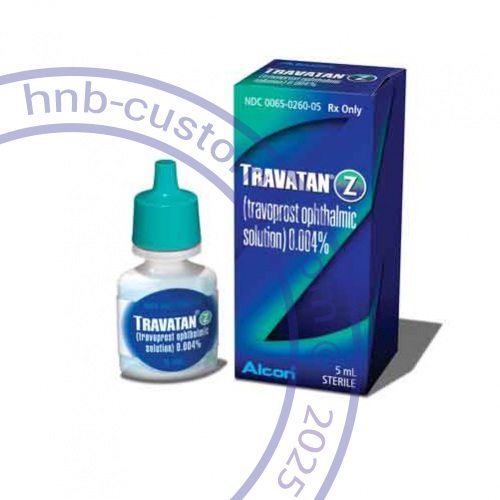Travoprost ophthalmic
What is travoprost ophthalmic?
Travoprost lowers pressure inside the eye by increasing the amount of fluid that drains from the eye.
Travoprost ophthalmic (for the eyes) is used to treat certain types of glaucoma and other causes of high pressure inside the eye.
Travoprost ophthalmic may also be used for purposes not listed in this medication guide.
Warnings
Follow all directions on your medicine label and package. Tell each of your healthcare providers about all your medical conditions, allergies, and all medicines you use.
Before taking this medicine
You should not use travoprost ophthalmic if you are allergic to it.
To make sure travoprost ophthalmic is safe for you, tell your doctor if you have ever had:
- swelling or an infection in your eye;
- retinal detachment; or
- eye surgery or injury affecting the lens of your eye.
Travoprost ophthalmic may cause a gradual change in the color of your eyes or eyelids and lashes, usually an increase in brown pigment. You may also notice increased growth or thickness of your eyelashes. These changes occur slowly and you may not notice them for months or years. Color changes may be permanent even after your treatment ends, and may occur only in the eye being treated. This could result in a cosmetic difference in eye or eyelash color from one eye to the other.
It is not known whether travoprost ophthalmic will harm an unborn baby. Tell your doctor if you are pregnant or plan to become pregnant.
It is not known whether travoprost ophthalmic passes into breast milk or if it could affect the nursing baby. Tell your doctor if you are breast-feeding.
Travoprost ophthalmic is not approved for use by anyone younger than 16 years old.
How should I use travoprost ophthalmic?
Follow all directions on your prescription label. Do not use this medicine in larger or smaller amounts or for longer than recommended.
The usual dose of this medicine is 1 drop into the affected eye every evening. Follow your doctor's dosing instructions very carefully.
Do not use this medicine while wearing contact lenses. Travoprost ophthalmic may contain a preservative that can discolor soft contact lenses. Wait at least 15 minutes after using this medicine before putting in your contact lenses.
Wash your hands before using the eye drops.
To apply the eye drops:
- Tilt your head back slightly and pull down your lower eyelid to create a small pocket. Hold the dropper above the eye with the tip down. Look up and away from the dropper and squeeze out a drop.
- Close your eyes for 2 or 3 minutes with your head tipped down, without blinking or squinting. Gently press your finger to the inside corner of the eye for about 1 minute, to keep the liquid from draining into your tear duct.
- Wait at least 5 minutes before using any other eye drops your doctor has prescribed.
Do not touch the tip of the eye dropper or place it directly on your eye. A contaminated dropper can infect your eye, which could lead to serious vision problems.
Do not use the eye drops if the liquid has changed colors or has particles in it. Call your pharmacist for new medicine.
Tell your doctor right away if you have any eye injury or eye infection.
If you need surgery (including eye surgery), tell the surgeon ahead of time that you are using travoprost ophthalmic. You may need to stop using the medicine for a short time.
Store at cool room temperature, away from moisture and heat. Keep the bottle tightly closed when not in use.
What should I avoid while using travoprost ophthalmic?
Do not use other eye medications unless your doctor tells you to.
Travoprost ophthalmic side effects
Get emergency medical help if you have signs of an allergic reaction: hives; difficult breathing; swelling of your face, lips, tongue, or throat.
Stop using travoprost and call your doctor at once if you have:
- eye swelling, redness, severe discomfort, crusting or drainage (may be signs of infection);
- red, swollen, or itchy eyelids;
- increased sensitivity to light;
- vision changes; or
- severe burning, stinging, or irritation after using travoprost ophthalmic.
Common side effects may include:
- pain, itching, or redness of the eyes;
- puffy eyelids; or
- blurred vision.
What other drugs will affect travoprost ophthalmic?
It is not likely that other drugs you take orally or inject will have an effect on travoprost used in the eyes. But many drugs can interact with each other. Tell each of your healthcare providers about all medicines you use, including prescription and over-the-counter medicines, vitamins, and herbal products.





